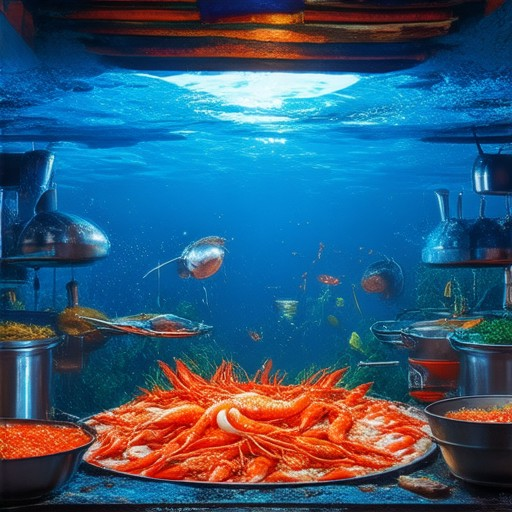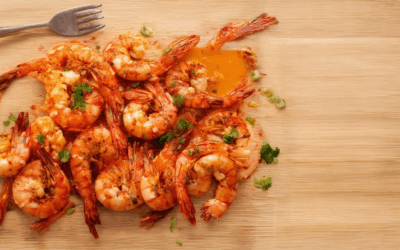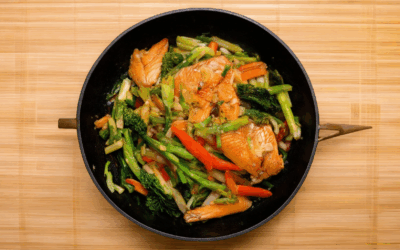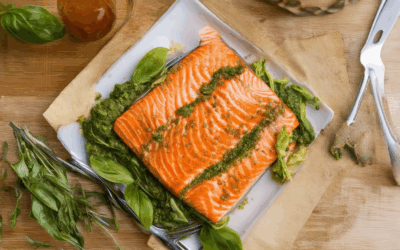Discover the art of cooking seafood like a pro with our comprehensive guide to proven techniques and recipes that will transform your meals into delicious experiences. Whether you’re planning a casual family dinner or preparing for a sophisticated gathering, seafood offers endless possibilities to captivate your senses. From grilled favorites to-boiled delicacies, we explore the best methods to cook seafood, ensuring every bite is flavorful and memorable. Learn how to master simple recipes, conquer frozen seafood, and discover the secrets behind creating stunning seafood dishes that will impress anyone who tries them. With expert tips and easy-to-follow instructions, this guide is your ultimate resource for turning ordinary meals into extraordinary ones.
Key Takeaways
– Master Multiple Cooking Methods: Learn expert techniques for baking, pan-frying, grilling, and deep-frying frozen seafood to achieve perfect results.
– Proper Defrosting is Critical: Choose between overnight refrigeration or rapid thawing methods to preserve texture and enhance flavor.
– Cook Frozen Shrimp Safely: Adjust cooking times for frozen shrimp, while thawed shrimp offer superior texture and taste for a sweeter dining experience.
– Enhance Flavor with Proper Preparation: Use seasonings, coatings, and preheating for optimal flavor and texture in your seafood dishes.

What Are the Most Popular Seafood Dishes?
The popularity of seafood dishes varies widely depending on cultural preferences regional cuisines and personal tastes. However, certain types of seafood consistently remain favorites globally due to their versatility and availability. Below are some of the most popular seafood dishes:
- Shrimp Scampi : A beloved dish featuring succulent shrimp cooked in garlic butter and lemon juice, often served over rice or pasta.
- Salmon : Known for its rich flavor, salmon is a favorite for grilling, baking, and poaching. Popular preparations include Grilled Salmon with Lemon-Dill Sauce and Baked Salmon with Garlic and Herbs.
- Ceviche : A traditional Peruvian dish made from raw fish marinated in lime juice, often served with potatoes and corn. A classic example is Ceviche Lime-Marinated.
- Lobster Bisque : A creamy and luxurious soup made with lobster meat, heavy cream, and sherry wine, offering a hearty and flavorful experience.
- Steamed Clams with Garlic Butter : Fresh clams steamed in a savory garlic butter sauce, often paired with bread or pasta, is a favorite coastal dish.
- Mussels with Spicy Tomato Sauce : Mussels are a popular ingredient in many Italian and Mediterranean dishes, such as Spicy Mussels with White Wine Garlic Sauce.
- Crab Cakes : These bite-sized treats are a favorite for seafood lovers, especially the classic Maryland Crab Cakes.
- Tuna Sushi Rolls : Fresh tuna prepared in various sushi forms, such as California Rolls and Sushi-grade Tuna Rolls, remains a staple in Japanese cuisine.
These dishes showcase the diversity and deliciousness of seafood, catering to a wide range of tastes and dietary preferences. Whether you prefer cold appetizers or hearty main courses, seafood offers a versatile and nutritious option for meals.
For more recipe ideas and detailed instructions, visit our seafood recipe hub .
What to Cook for a Seafood Dinner?
- Grilled Fish Recipes:
- Lemon Garlic Butter Salmon
- Grilled Fish Tacos with Mango Salsa
- Grilled Bass with Rosemary and Lemon
- Tilapia with Pineapple Glaze
- Shellfish Dishes:
- Garlic Shrimp Pasta
- Shrimp Stir-Fry with Vegetables
- Lobster Boil with Corn and Potatoes
- Garlic Butter Crab Cakes
- Clam Chowder Soup
- Mussels with Garlic and White Wine
- Crustacean Delights:
- Crab Bisque
- Crayfish Thermidor
- Blue Crab Quesadilla
- Mollusk Meals:
- Calamari Fried with Aioli
- Seared Scallops with Bacon
- Ceviche Salad
- Main Course Ideas:
- Seafood Grill Platter
- Paella Valenciana with Seafood
- Beef and Seafood Skewers
- Dessert Options:
- Fruit Salad with Lime Dressing
- Coconut Haupia
- More Seafood Inspiration:
- Fish Cooking Tips
- Explore More Seafood Recipes

Best Cooking Methods for Seafood
The best cooking method for seafood depends on the type of fish and personal preference. Here are some popular methods:
- Grilling: Ideal for firm fish like salmon, tuna, and swordfish. Use a grill basket for smaller pieces to prevent flaking.
- Baking: Great for fish like cod, halibut, and tilapia. Season with herbs, lemon, and olive oil for a simple dish.
- Pan-Frying: Versatile for most fish types. Keep the heat medium-low to avoid overcooking. Use a splatter guard for easier cleanup.
- Deep-Frying: Best for breaded or battered fish like fish sticks or tempura. Requires flour or cornmeal coating and oil temperature control.
- Steaming: A healthy option for delicate fish like sole or trout. Preserves moisture and flavor without added fats.
- Poaching: Low-fat method ideal for fish like tilapia or catfish. Use broth, wine, or butter for added flavor.
- Smoking: Adds a unique flavor to fish like salmon or trout. Can be done at home using a smoker box or purchased pre-smoked.
Each method has its benefits, so experiment to find your favorite way to prepare seafood. Whether you prefer grilling, baking, or frying, there’s a technique that suits every taste preference and skill level.

What is the Best Way to Cook Frozen Seafood?
Cooking frozen seafood can be a convenient and delicious option for any meal. Whether you’re a seasoned chef or new to working with frozen ingredients, follow these simple tips to get the best results:
1. Baking or Roasting
Baking is a versatile method that works well for many types of frozen seafood. Here’s how to do it:
- Preheat Oven:** Set your oven to 450°F (230°C). This temperature is ideal for sealing the surface of the seafood without overcooking it.
- Prepare Seafood:** Lightly rinse the seafood under cold water to remove any ice crystals, then pat it dry with a paper towel.
- Season:** Sprinkle with your favorite seasonings, such as lemon pepper, garlic powder, or herbs.
- Bake:** Place the seafood on a baking sheet or roasting pan. For even cooking, place it in a single layer, leaving space between pieces to promote air circulation.
- Cook Time:** Most frozen seafood takes about 10-15 minutes to cook. Check for doneness by looking for opacity and flaking easily with a fork.
Tips: For a crispy texture, brush the seafood with olive oil before baking. Add vegetables like broccoli or potatoes to the same pan for a complete meal.
2. Pan-Frying
Pan-frying is a great method for those who prefer a bit of oil and a crispier finish:
- Heat Oil:** Use a medium-sized skillet or frying pan and add a thin layer of vegetable oil or butter.
- Prep Seafood:** Pat the seafood dry with a paper towel to ensure it seizes properly.
- Cook:** Fry the seafood for about 3-4 minutes per side until golden brown and cooked through. Remove from heat and drain on paper towels.
Tips: For a healthier option, use olive oil or coconut oil. Add garlic, onions, or spices to the pan for added flavor.
3. Grilling
Grilling is perfect for those who love the smoky flavor of cooking outdoors:
- Preheat Grill:** Set your grill to medium-high heat, around 400-450°F (200-230°C).
- Prepare:** Rinse and pat dry the seafood. Lightly brush with olive oil or a specialty seafood rub.
- Grill Time:** Cook for about 3-4 minutes per side, depending on the thickness of the seafood. Flip once for even cooking.
Tips: Use a grill basket or skewers for smaller pieces to prevent them from falling through the grates. Add wood chips for smoke flavor if desired.
4. Deep-Frying
Deep-frying is a classic method for achieving a crispy exterior:
- Heat Oil:** Fill a large Dutch oven or deep pan with enough oil to fully submerge the seafood (about 1-1.5 inches of oil). Heat to 350°F (175°C).
- Fry:** Carefully lower the seafood into the hot oil and fry for 3-4 minutes per side until golden and cooked through. Remove and drain on paper towels.
Tips: Use a candy thermometer to monitor oil temperature. Fry in small batches to avoid overcrowding the pan and cooling the oil too much.
General Tips for Success
- Don’t Overcook:** Seafood becomes tough and rubbery when overcooked. Check for doneness by testing with a fork or knife.
- Use Proper Tools:** A good metal spatula or slotted spoon is essential for flipping and removing seafood from the pan or grill.
- Serve Fresh:** Once cooked, serve immediately to retain maximum flavor and texture.
With these methods, you can enjoy delicious and perfectly cooked frozen seafood every time. Experiment with different seasonings and cooking techniques to discover your personal favorites!
Should You Defrost Frozen Seafood Before Cooking?
Defrosting frozen seafood properly is crucial for achieving the best texture and flavor. Here’s a detailed guide to ensure your seafood is cooked perfectly:
How to Properly Defrost Frozen Seafood
- Nighttime Thawing: Remove the seafood from the freezer the night before cooking. Place it in the refrigerator to thaw slowly. This method preserves the seafood’s texture and flavor.
- Rapid Thawing Methods: If you’re short on time, place the seafood in a sealed bag and immerse it in cold water. Check frequently to avoid overdefrosting, as this can lead to a mushy texture.
- Never Refreeze: Once seafood has started to thaw, it shouldn’t be refrozen. Cook it immediately to prevent ice crystals from forming, which can affect the taste and texture.
Cooking Tips for Frozen Seafood
- Preheat Oven or Grill: Make sure your cooking appliance is preheated to the recommended temperature for the type of seafood you’re cooking. This ensures even cooking.
- Bread or Coatings: For dishes like fish sticks or breaded shrimp, coat the seafood in flour or breadcrumbs before freezing. This helps maintain crispiness during cooking.
- Use a Skillet or Pan: Cooking frozen seafood in a skillet or pan over medium heat works well for most types of fish. Add a bit of oil or butter to prevent sticking.
When to Keep Seafood Frozen
- Fish fillets and steaks can usually be cooked frozen, though they may take slightly longer. Ensure they reach an internal temperature of 145°F (about 63°C) for safe consumption.
- Shrimp and scallops can be cooked frozen, often requiring just a few minutes in a hot pan. Check for doneness by looking for color changes or firmness.
Safety Guidelines
- Always check that seafood is fully cooked before serving. Use a food thermometer to verify internal temperatures.
- Freezing and thawing seafood can affect its texture, so plan accordingly based on your preferred cooking method.
By following these steps, you can enjoy delicious and safely prepared frozen seafood every time. Whether you’re a seasoned chef or new to cooking seafood, proper defrosting and cooking techniques will elevate your dishes to perfection!

Boiling Frozen vs. Thawed Shrimp
When deciding whether to boil frozen or thawed shrimp, consider the following:
- Frozen Shrimp: Safe to cook and retains nutritional value. Ideal for quick meals. Adjust cooking time as needed for optimal doneness.
- Thawed Shrimp: Tends to have better texture due to retained moisture. Enhances flavor with a sweeter taste.
- Convenience:** Frozen shrimp cooks faster, perfect for busy schedules. Thawed shrimp requires planning but may offer superior taste.
Both options are viable; choose based on your preferences and availability. Enjoy your seafood dishes!




0 Comments